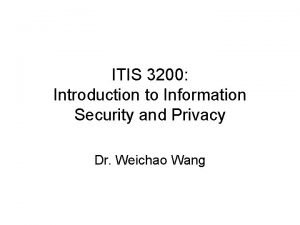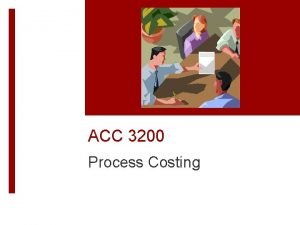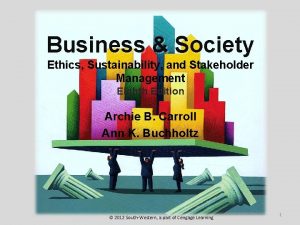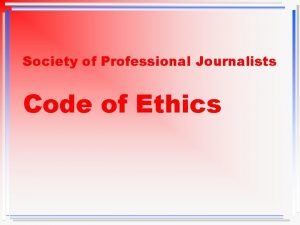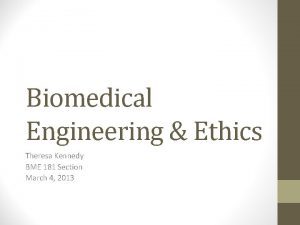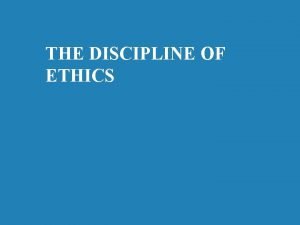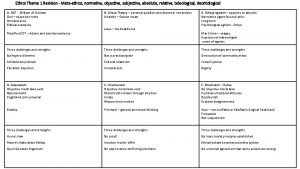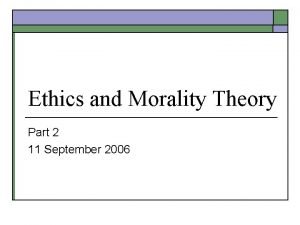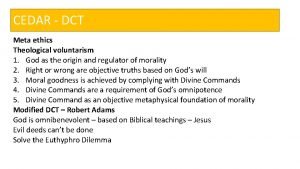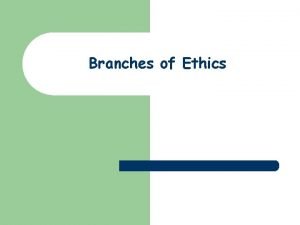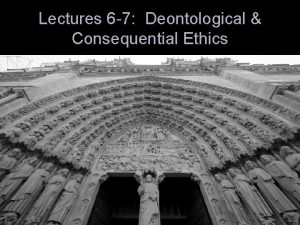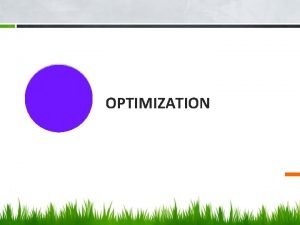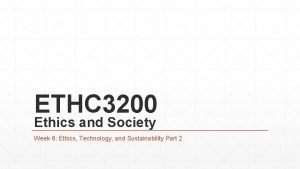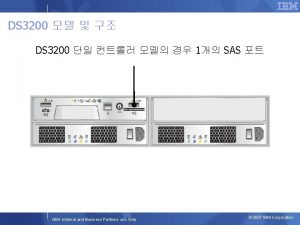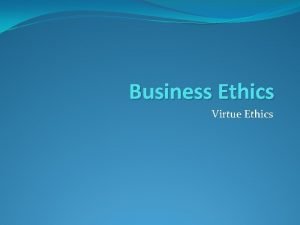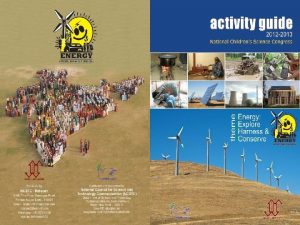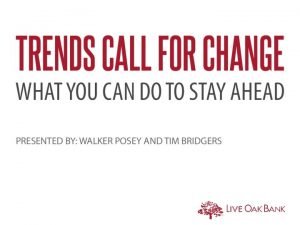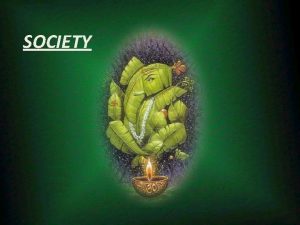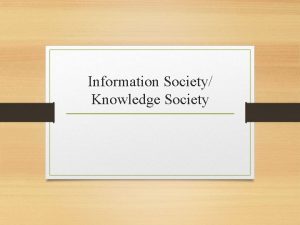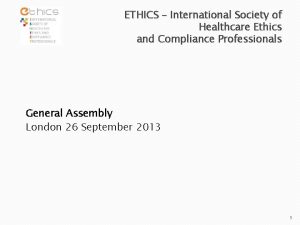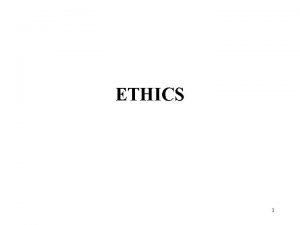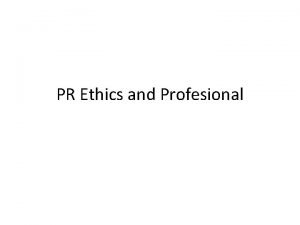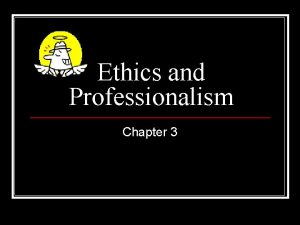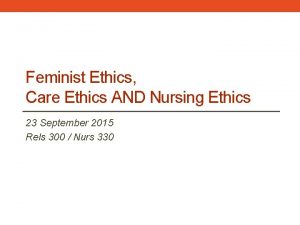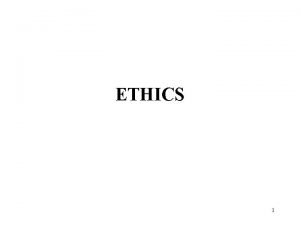ETHC 3200 Ethics and Society Week 7 Ethics
































- Slides: 32

ETHC 3200 Ethics and Society Week 7: Ethics and the Environment

Sustainability ▪ Read Desjardins (2014) – Chapter 10 – Business’s Environmental Responsibilities ▪ Sustainability in this chapter is defined as the ability to meet the needs of the present without compromising the ability of future generations to meet their own needs (Gro Bruntland of Norway). Copyright © 2014 by Mc. Graw-Hill Education. All rights reserved. 10 -2

Discussion Case: Nike ▪ In the 1990 s, Nike was criticized for alleged sweatshop labor conditions in the plants manufacturing its shoes in such countries as Vietnam and China ▪ Nike originally denied any responsibility for the actions of the manufacturing plants ▪ This perspective changed, due in part to strong public pressure ▪ Since the mid-1990 s, Nike has steadily moved towards a leadership position in sustainability ▪ Nike instituted a more aggressive policy to ensure that its suppliers were complying with ethical labor standards ▪ Nike acknowledged that it had a social responsibility for activities all along its supply chain Copyright © 2014 by Mc. Graw-Hill Education. All rights reserved. 10 -3

Discussion Case: Nike (cont. ) ▪ In 2010, Nike released the results of a two-year study of its corporate social responsibility activities and introduced the next phase of its efforts, which explicitly focuses on a sustainability strategy ▪ Nike described its corporate social responsibility efforts as evolving from a “risk management, philanthropic and compliance model to a long-term strategy focused on innovation, collaboration, transparency and advocacy to prepare the company to thrive in a sustainable economy. ” Copyright © 2014 by Mc. Graw-Hill Education. All rights reserved. 10 -4

Discussion Case: Patagonia ▪ Patagonia, the outdoor gear, equipment, and clothing company, has been a leader in the sustainability movement ▪ For Patagonia, profitability and sustainability merge rather than conflict ▪ Its mission statement includes: “For us at Patagonia, a love of wild and beautiful places demands participation in the fight to save them, and to help reverse the steep decline in the overall environmental health of our planet. ” Copyright © 2014 by Mc. Graw-Hill Education. All rights reserved. 10 -5

Discussion Case: Patagonia (cont. ) ▪ Patagonia’s sustainable business practices include using recycled synthetics and pesticide-free organic cotton in its clothing lines ▪ It donates at least 1% of profits to environmental causes ▪ It pledges to: ▪ Reduce resource use ▪ Repair products to extend their life ▪ Reuse products by reselling or giving them to others ▪ Recycle what cannot be repaired or reused ▪ Reimagine a world in which humans live in harmony with nature Copyright © 2014 by Mc. Graw-Hill Education. All rights reserved. 10 -6

Discussion Case: Patagonia (cont. ) ▪ A pioneering aspect of Patagonia’s commitment to sustainability is its “footprint chronicles, ” a wide-ranging project that aims for full transparency in supply chain operations ▪ On-line disclosure of all mills and production factories used to create Patagonia’s products ▪ Online disclosure of factories’ locations, what products are made there, how many people are employed, the languages spoken, the percentage of male and female workers, and updated information from recent social audits Copyright © 2014 by Mc. Graw-Hill Education. All rights reserved. 10 -7

Market Failures and the Environment ▪ Three main market failures show the inadequacy of the economic model of corporate social responsibility 1. The existence of externalities ▪ “Costs” of greenhouse gas emissions, air pollution, groundwater contamination and depletion, soil erosion, and nuclear waste disposal are typically borne by parties “external” to the economic exchange ▪ Thus, free market exchanges cannot guarantee optimal results Copyright © 2014 by Mc. Graw-Hill Education. All rights reserved. 10 -8

Market Failures and the Environment (ctd. ) 2. No markets exist to create a price for important social goods ▪ Endangered species, scenic vistas, rare plants and animals, and biodiversity ▪ Public goods such as a stable climate, clean air, and ocean fisheries ▪ Thus, markets alone fail to guarantee that such important public goods are preserved and protected. Copyright © 2014 by Mc. Graw-Hill Education. All rights reserved. 10 -9

Market Failures and the Environment (ctd. ) 3. Important ethical and policy questions can be missed if policy decisions are left solely to the outcome of individual decisions ▪ The overall social result of individual calculations might be significant increases in pollution and such pollution-related diseases as asthma and allergies ▪ Alternative policies that could address pollution and pollution-related disease would never be considered if we relied only on market solutions ▪ Thus, markets are incomplete (at best) in their approach to the overall social good. Copyright © 2014 by Mc. Graw-Hill Education. All rights reserved. 10 -10

Responses to Market Failures ▪ Two responses to market failures related to the environment are the internalization of external costs and the assigning of property rights to unowned goods such as wild species. ▪ However, there are good reasons to think that such ad hoc attempts to repair market failures are environmentally inadequate. ▪ One reason is the first-generation problem: this means that markets can work to prevent harm only through information supplied by the existence of market failures. (Eg. The limits of cod populations are only known once over-fishing has occurred; or dangers of pesticides are only know once health problems occur. ) This problem is somewhat opposite to the precautionary principle. Copyright © 2014 by Mc. Graw-Hill Education. All rights reserved. 10 -11

Environmental Ethics and Business ▪ Under a free-market approach, society has two opportunities to establish business’ environmental responsibilities: ▪ As consumers, individuals could demand environmentally friendly products in the marketplace ▪ As citizens, individuals could support environmental legislation ▪ As long as business responded to the market and obeyed the law, it met its environmental responsibilities. ▪ However, absent law or consumer demand, it suggests business has no particular environmental responsibility. ▪ This approach would prove inadequate over the long term because: ▪ It underestimates the influence that business can have in establishing the law ▪ It underestimates the ability of business to influence consumer choice ▪ If we rely on the law to protect the environment, environmental protection will extend only as far as the law extends Copyright © 2014 by Mc. Graw-Hill Education. All rights reserved. 10 -12

Environmental Ethics and Business (ctd. ) ▪ Perhaps most troubling from an environmental standpoint, the regulatory model assumes that economic growth is environmentally and ethically benign. There are, however, many different ways to pursue profits within the side constraints of law. ▪ More recent approaches to business’s environmental responsibilities aim to better link economic and environmental goals. Copyright © 2014 by Mc. Graw-Hill Education. All rights reserved. 10 -13

Environmental Ethics and Business (ctd. ) ▪ Business has wider environmental responsibilities than those required under a narrow free-market approach. ▪ A common alternative argues that some goods are so important that they should be exempt from the preference optimizing trade-offs that occur within markets. ▪ This alternative would support limits, typically in the form of government regulation, on business’s economic goals. Copyright © 2014 by Mc. Graw-Hill Education. All rights reserved. 10 -14

Environmental Ethics and Business (ctd. ) American economist Herman Daly argues ▪ There are biological, physical, and ethical limits to growth which the world economy is approaching. ▪ Unless we make significant changes in our understanding of economic activity, we will fail to meet very basic ethical and environmental obligations. Copyright © 2014 by Mc. Graw-Hill Education. All rights reserved. 10 -15

Circular Flow Model Consumer goods and services Wages, rents, interests, profits Business Households Resources: labor, land, Capital, entrepreneurial skills Payments Copyright © 2014 by Mc. Graw-Hill Education. All rights reserved. 10 -16

Circular Flow Model ▪ According to the circular flow model: ▪ Business produces good and services in response to the market demands of households ▪ Goods and services are shipped to households in exchange for payments back to business ▪ These payments are in the form of wages, salaries, rents, profits and interests ▪ These payments are in exchange for the labor, land, capital and skills used to produce goods and services Copyright © 2014 by Mc. Graw-Hill Education. All rights reserved. 10 -17

Circular Flow Model (ctd. ) ▪ In the Circular Flow Model, natural resources are undifferentiated from the other factors of production. ▪ This model treats economic growth as boundless and the solution to all social ills. As seen earlier in the course, the measure of wellbeing according to this model is GDP. Copyright © 2014 by Mc. Graw-Hill Education. All rights reserved. 10 -18

Circular Flow Model (ctd. ) Challenges to this model: 1. A large percentage of the world lives in poverty. 2. This population, particularly in impoverished areas, will increase significantly. 3. The only sources for economic activity are the natural resources of the earth. Copyright © 2014 by Mc. Graw-Hill Education. All rights reserved. 10 -19

Circular Flow Model (ctd. ) ▪ Daly argues that neoclassical economics will fail to meet these challenges unless it recognizes that the economy is but a subsystem within the Earth’s biosphere. ▪ A model of an economic system that uses resources only at a rate that can be sustained follows. Copyright © 2014 by Mc. Graw-Hill Education. All rights reserved. 10 -20

Solar Energy Biosphere Consumer goods and services Wages, rents, interests, profits Heat Energy, Business Households Nat’l Resources: labor, land, Capital, entrepreneurial skills Wastes (pollution, trash) Nat’l Resources Waste (pollution, trash) Payments Copyright © 2014 by Mc. Graw-Hill Education. All rights reserved. 10 -21

New Sustainable Model ▪ In the new model there is a recognition that the economy exists within a finite biosphere ▪ Energy is lost at every stage of economic activity ▪ Natural resources are no longer treated as an undifferentiated and unexplained factor of production emerging from households ▪ Wastes are produced at each stage of economic activity and dumped back into the biosphere Copyright © 2014 by Mc. Graw-Hill Education. All rights reserved. 10 -22

Environment and Business ▪ We must move away from the view of environmental responsibilities as side constraints on the pursuit of profit, as if there were only one way to pursue profits, and as if ethical responsibilities were a barrier to that pursuit. Copyright © 2014 by Mc. Graw-Hill Education. All rights reserved. 10 -23

Environment and Business (ctd. ) Natural Capitalism by Paul Hawken, Amory Lovins and Hunter Lovins, offers four guiding principles for the redesign of business: 1. The productivity of natural resources can be increased 2. Biomimicry requires that business be redesigned to model biological processes 3. Traditional models of business should be replaced with a model of business as a provider of service 4. Business must reinvest in natural capital Copyright © 2014 by Mc. Graw-Hill Education. All rights reserved. 10 -24

Environment and Business (ctd. ) ▪ Business managers have a responsibility to seek ways to integrate former wastes back into the production system, transform wastes into biologically beneficial elements or, minimally, to produce wastes at rates no faster than the biosphere can absorb them. ▪ A service-based economy interprets consumer demand as a demand for services, e. g. clothes cleaning, floor-covering, illumination, entertainment, cool air, transportation, word processing. Copyright © 2014 by Mc. Graw-Hill Education. All rights reserved. 10 -25

Environment and Business (ctd. ) ▪ The biosphere is a true public good ▪ Reinvestment in natural capital is perhaps one business responsibility that should be especially subject to government regulation ▪ Tax incentives to encourage such investment and tax penalties for uncompensated resource extraction are options Copyright © 2014 by Mc. Graw-Hill Education. All rights reserved. 10 -26

Is Sustainability Enough? ▪ Let’s critique Desjardin’s (2014) chapter 10 in a deeper way. Recall Daniel Wahl’s (2017) claim that “sustainability is not enough”. This short video (1: 33 min) reminds us why https: //www. youtube. com/watch? v=Spc. Dcm. Oi. LZ 0. ▪ It’s time to switch from a business perspective to the perspective of a human being that is part of the living system we call the biosphere.

Restoration ▪ American ecologist John D. Liu provides an example of what ecological restoration can look like. Read the John D. Liu interview: “It is possible to rehabilitate large-scale damaged ecosystems” (Available in Moodle). ▪ Watch John D. Liu’s video “Forests keep drylands working” (Available in Moodle). ▪ Liu (2016) reminds us that “it is important to see that some of the things that happened in the past were mistakes. We need to recognize and correct these mistakes” (para. 3). Create a journal entry reflecting on the difference between ecosystem function and ecosystem services as outlined in the article. How might a shift in worldview toward caring for ecosystem function influence our economic, social, and cultural systems?

The Great Work ▪ Read Thomas Berry’s (2010) The great work. In Nelson, M. P. , & Moore, K. D. (2010). Moral ground: Ethical action for a planet in peril. San Antonio, TX: Trinity University Press. (Available in Moodle) ▪ Create a journal article summarizing what you found most engaging in this week’s readings. How has this material influenced the way you understand our responsibilities toward the biosphere?

Environmental Leaders ▪ Obviously, the environment is a topic outside business as well. Ever since the move toward industrial culture in the West, thinkers have been concerned about the environment. ▪ Many works of the 20 th and 21 st century have pointed out the need for a new way of thinking about the environment. ▪ In 1949, American Aldo Leopold published A Sand County Almanac, in which he emphasized ecological connectivity and humans’ place in this web, and called for a “land ethic” that ensured care for the land rather than regard for it simply as a resource. ▪ In 1962, Rachel Carson published Silent Spring about the environmental destruction caused by DDT and other pesticides. This book sparked the modern environmental movement.

Environmental Leaders (ctd. ) ▪ In 2015, Pope Francis weighed in on the environmental topic, presenting an encyclical called Laudato Si: On Care for our Common Home. This work reflects a thorough understanding of ecology and the need for people everywhere to reintegrate culture and nature. It is long but worth reading, especially considering the Pope’s influence over many people around the world. http: //w 2. vatican. va/content/francesco/en/encyclicals/documents/papafrancesco_20150524_enciclica-laudato-si. html ▪ The Dalai Lama has also written about the environment, calling its stewardship a universal responsibility. This work is also very worthwhile reading. https: //www. dalailama. com/messages/environment/universal-responsibility ▪ Winona La. Duke of the Ashinaabe First Nation is also an environmental leader. She established Honor the Earth to create awareness and advocate for environmental protection: http: //www. honorearth. org/

Environment and Us ▪ Our relationship with the environment is an ethical issue. ▪ In your journal, reflect on your environmental values and what you are doing in your own life to help “turn the ship around, ” away from a degenerative relationship to a regenerative relationship with nature.
 Week by week plans for documenting children's development
Week by week plans for documenting children's development Casio normal distribution
Casio normal distribution Itis 3200
Itis 3200 Gvc video conference
Gvc video conference System-storage-manager
System-storage-manager Fuji 3200
Fuji 3200 Powermate microsoft
Powermate microsoft Mandated reporter michigan
Mandated reporter michigan Acc 3200
Acc 3200 Business and society ethics and stakeholder management
Business and society ethics and stakeholder management Gertler econ
Gertler econ Difference between micro ethics and macro ethics
Difference between micro ethics and macro ethics Society for professional journalists code of ethics
Society for professional journalists code of ethics Biomedical engineering society code of ethics
Biomedical engineering society code of ethics Descriptive ethics vs normative ethics
Descriptive ethics vs normative ethics Briefly summarise
Briefly summarise Descriptive ethics vs normative ethics
Descriptive ethics vs normative ethics Meta ethics vs normative ethics
Meta ethics vs normative ethics Descriptive ethics vs normative ethics
Descriptive ethics vs normative ethics Compensatory justice examples
Compensatory justice examples Metaethics vs normative ethics
Metaethics vs normative ethics Metaethics
Metaethics Teleological ethics vs deontological ethics
Teleological ethics vs deontological ethics Teleological ethics vs deontological ethics
Teleological ethics vs deontological ethics A deli sells 640 sandwiches
A deli sells 640 sandwiches Pros and cons of a four day school week
Pros and cons of a four day school week Days of the week and months of the year
Days of the week and months of the year School subjects and days of the week
School subjects and days of the week Romeo and juliet act 3 timeline
Romeo and juliet act 3 timeline Htcondor week
Htcondor week Htcondor vs slurm
Htcondor vs slurm Med tech week
Med tech week Dgp week 9
Dgp week 9


